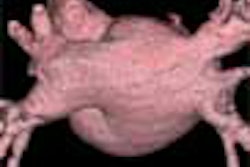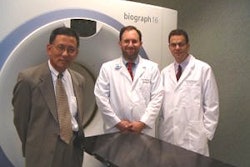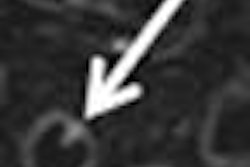A new study has found that aortic atherosclerosis can be accurately predicted by measuring the compliance or stiffness of arteries in a patient's leg -- an approach that could trump CT coronary calcium scanning for identifying subclinical heart disease.
However, further development of this new approach is currently in limbo because the company that engineered the portable blood-volume device used in the study, Vasocor of Charleston, NC, has gone bankrupt.
"This is a classic example of a promising technology that ran out of money before they actually made it to the commercial market," said lead author Dr. David Herrington, a cardiologist at Wake Forest University Baptist Medical Center in Winston-Salem, NC.
"But the data are the data," Herrington said. "I think it's likely, after these results, that somebody is going to recognize this is an opportunity and will probably reinvest in the company and allow it to move forward."
The findings on lower-extremity arterial stiffness and its relationship to subclinical aortic atherosclerosis were published in the latest issue of the American Heart Association's medical journal (Circulation, July 27, 2004, Vol. 110:4, pp. 432-437).
Blood vessels become less pliable and begin to stiffen in the early stages of atherosclerosis due to plaque buildup. With this general knowledge, the researchers measured peripheral arterial compliance using Vasocor's fully automated, computer-controlled air plethysmograph, composed of an air pump, calibration chamber, and high-resolution pressure transducer.
Measurements were obtained from the patient via standard blood pressure cuffs placed at the thigh and calf. The arterial-compliance results for 268 enrolled patients were then compared to MRI-confirmed findings of aortic atherosclerosis in the same patients.
When compared to the standard noninvasive, nonimaging predictors of coronary risk, the arterial-compliance measurements proved superior. Reduced arterial compliance was more strongly associated with aortic atherosclerosis than Framingham Coronary Risk Score (FCRS) or the combination of FCRS and C-reactive protein (p < 0.0001), the authors noted.
"I think this proves the principle that measuring arterial compliance or arterial stiffness may be a useful adjunct to other measures that we typically employ in clinical practice to assess risk for heart disease," Herrington said.
Such an approach would also have potential for mass screening of asymptomatic patients, Herrington said, given that the portable plethysmograph device could be used in doctors' offices by minimally trained personnel.
Arterial-compliance measurements would also identify atherosclerosis at earlier stages than coronary calcium scanning, according to Herrington and his co-authors.
By comparison, although CT coronary calcium screening has been touted by some proponents, its prospects for large-scale use may look best when compared to the costs and logistics of a hypothetical MR-based screening approach.
But CT scanning has a head start over arterial compliance plethysmography on the research front, Herrington acknowledged. In particular, studies have already shown a relationship between coronary calcium and future risk of myocardial infarction (MI) or coronary heart disease (CHD) events.
"We've shown that (arterial compliance) is related to risk for extensive atherosclerosis, but we haven't shown that it predicts risk for MIs and CHD death," Herrington said. "And that's clearly something that is the reasonable next step in the ongoing evaluation of this approach."
By Tracie L. ThompsonAuntMinnie.com staff writer
July 30, 2004
Related Reading
Coronary calcium score is an effective prognostic tool for patients with diabetes, May 24, 2004
Mass-based CT calcium scoring leaves room for dose reduction, April 30, 2004
Radiologists correlate coronary calcium with other CVD markers, April 6, 2004
Coronary calcium screening worthwhile in asymptomatic patients at risk for CHD, August 27, 2003
Copyright © 2004 AuntMinnie.com



















